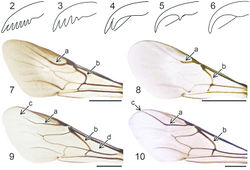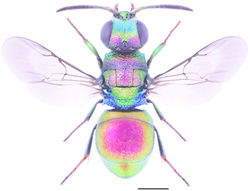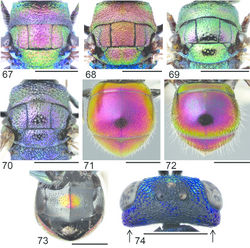Hedychridium ardens
| Notice: | This page is derived from the original publication listed below, whose author(s) should always be credited. Further contributors may edit and improve the content of this page and, consequently, need to be credited as well (see page history). Any assessment of factual correctness requires a careful review of the original article as well as of subsequent contributions.
If you are uncertain whether your planned contribution is correct or not, we suggest that you use the associated discussion page instead of editing the page directly. This page should be cited as follows (rationale):
Citation formats to copy and paste
BibTeX: @article{Paukkunen2015ZooKeys, RIS/ Endnote: TY - JOUR Wikipedia/ Citizendium: <ref name="Paukkunen2015ZooKeys">{{Citation See also the citation download page at the journal. |
Ordo: Hymenoptera
Familia: Chrysididae
Genus: Hedychridium
Name
Hedychridium ardens (Coquebert, 1801) – Wikispecies link – Pensoft Profile
- Chrysis ardens Coquebert, 1801: 59.
- Hedychrum minutum Lepeletier, 1806: 122.
- Chrysis integra Dahlbom, 1829: 17, not Fabricius, 1787.
- Hedychridium ardens: Frey-Gessner 1887[1]: 40.
Diagnosis
Length 3–5 mm. Both sexes have coppery red colour dorsally on the head, pronotum, mesoscutum, mesoscutellum and metasoma, whereas the frons, anterior corners of pronotum, metanotum, tibiae and apex of the metasoma are mainly greenish (Fig. 66). The propodeum and the mesopleuron are usually blue. The punctation of the mesoscutum (Fig. 67) is denser than in Hedychridium cupreum and Hedychridium purpurascens, but not as dense as in Hedychridium coriaceum. Small males are sometimes greenish all over with only weak coppery reflections dorsally, and can be confused with Hedychridium zelleri. The punctation of the mesoscutum is however sparser and coarser than in Hedychridium zelleri.
Distribution
Denmark, Estonia, Finland, Latvia, Lithuania, Norway, Sweden. Common. – Trans-Palearctic: Europe, Mongolia, Russian Far East (Kimsey and Bohart 1991[2], Linsenmaier 1997[3], Kurzenko and Lelej 2007[4]).
Biology
Habitat: sparsely vegetated sandy areas, dunes, dry meadows. Adults visit flowers of Apiaceae, Asteraceae, Crassulaceae, Euphorbiaceae and Rosaceae (Molitor 1935[5], our own obs.). Flight period: late May to late August. Host: Diodontus tristis (Vander Linden), Oxybelus bipunctatus Olivier, Tachysphex nitidus (Spinola), Tachysphex obscuripennis (Schenck) and Tachysphex pompiliformis (Panzer) (Crabronidae) (Trautmann 1927[6], Berland and Bernard 1938[7], Benno 1950[8], Else 1973[9], Kofler 1975[10], Morgan 1984[11], van der Smissen 2001[12]).
Taxon Treatment
- Paukkunen, J; Berg, A; Soon, V; Ødegaard, F; Rosa, P; 2015: An illustrated key to the cuckoo wasps (Hymenoptera, Chrysididae) of the Nordic and Baltic countries, with description of a new species ZooKeys, (548): 1-116. doi
Images
|
Other References
- ↑ Frey-Gessner E (1887) Fauna insectorum helvetiae. Hymenoptera. I. Chrysididae (Die Goldwespen). Schaffhausen, 90 pp.
- ↑ Kimsey L, Bohart R (1991) [1990] The Chrysidid Wasps of the World. Oxford Press, New York, 652 pp.
- ↑ Linsenmaier W (1997) Die Goldwespen der Schweiz. Veröffentlichungen aus dem Natur-Museum Luzern 9: 1–139.
- ↑ Kurzenko N, Lelej A (2007) Chrysididae. In: Lelej A Belokobylskiy S Kasparyan D Kupyanskaya A Proshchalkin M (Eds) Key to the insects of Russian Far East. Vol. IV. Neuropteroidea, Mecoptera, Hymenoptera. Part 5. Dal’nauka, Vladivostok, 998–1006.
- ↑ Molitor A (1935) Notizen betreffend Vorkommen, Ökologie und Phaenologie der Chrysididen Niederösterreichs und des Burgenlandes. Konovia 14: 1–7.
- ↑ Trautmann W (1927) Die Goldwespen Europas. Uschman, Weimar, 194 pp.
- ↑ Berland L, Bernard F (1938) Hyménoptères vespiformes. III. (Cleptidae, Chrysidae, Trigonalidae). Faune de France, Vol. 34. Paul Lechevalier, Paris, 145 pp.
- ↑ Benno P (1950) De Nederladse Goudwespen en haar verspreiding (Hym. Chrysididae, Cleptidae). Publicaties van het Natuurhistorisch Genootschap in Limburg 3: 9–48.
- ↑ Else G (1973) Recent records and notes of Omalus puncticollis (Mocsáry) and other local chrydidid wasps (Hym.) in Hampshire. The Entomologist’s Monthly Magazine 109: 120–122.
- ↑ Kofler A (1975) Die Goldwespen Osttirols (Insecta: Hymenoptera, Chrysididae). Carinthia II 85: 343–356.
- ↑ Morgan D (1984) Cuckoo-wasps, Hymenoptera, Chrysididae. Handbooks for the Identification of British Insects, Vol. 6, Part 5. Royal Entomological Society of London, London, 37 pp.
- ↑ van der Smissen J (2001) Die Wildbienen und Wespen Schleswig-Holsteins – Rote Liste. Band I-III. Landesamt für Natur und Umwelt des Landes Schleswig-Holstein. Flintbek, 138 pp.


